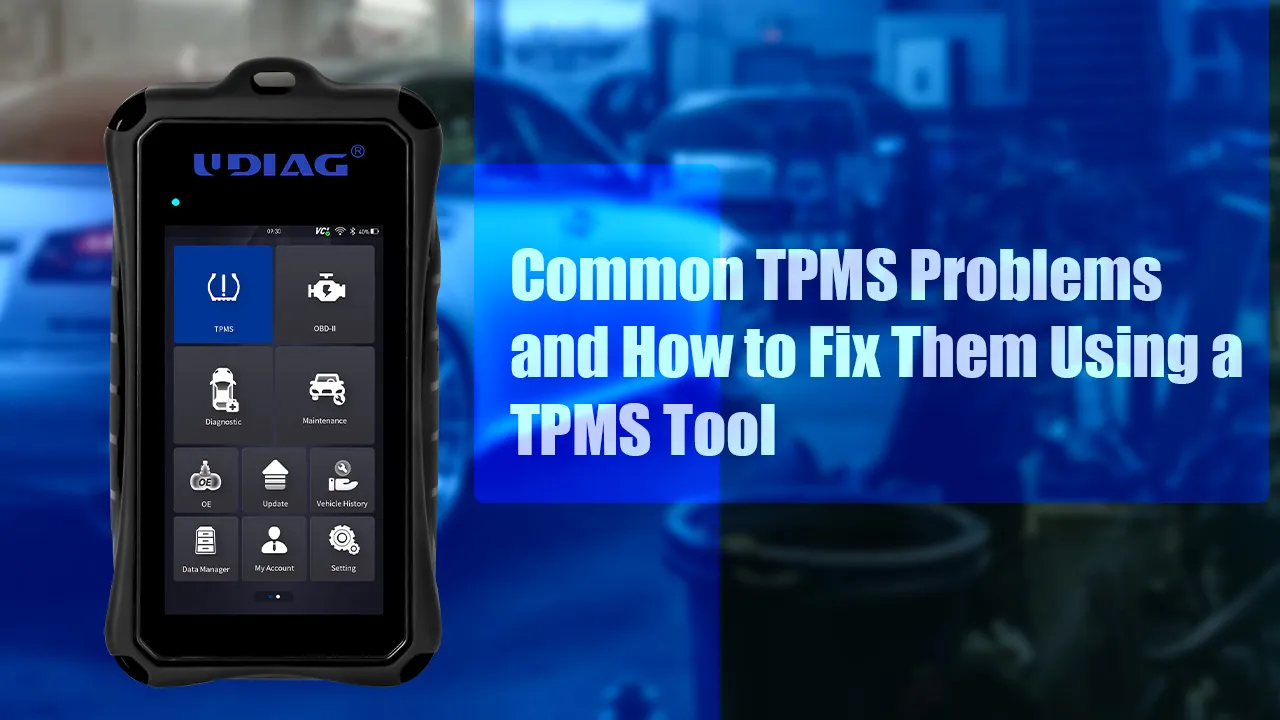Common TPMS Problems and How to Fix Them Using a TPMS Tool
2025-10-22 by UDIAG

Introduction:
Tire Pressure Monitoring Systems (TPMS) have become a standard safety feature in modern vehicles, helping drivers maintain optimal tire pressure and avoid potential accidents. However, like any electronic system, TPMS can experience issues that affect accuracy and reliability. Understanding common TPMS problems, and how to resolve them using specialized TPMS tools, is essential for automotive technicians and workshops looking to ensure safe and effective tire maintenance.
Understanding the Function of a TPMS Tool
A TPMS scan tool is a diagnostic and programming device designed to communicate with the tire pressure sensors installed in each wheel. It can read sensor data, identify faults, perform sensor activation, and even reprogram new sensors when replacements are needed. For workshops, a professional TPMS tool helps streamline diagnosis, reduce guesswork, and ensure that every vehicle leaves the shop with a fully functional monitoring system.
Common TPMS Problems in the Workshop
1. Faulty or Dead TPMS Sensors
One of the most common TPMS issues is sensor failure due to battery depletion or physical damage. Most TPMS sensors use a non-replaceable battery that lasts around 5–10 years. When the battery dies, the system can no longer transmit pressure data, triggering a warning light.
Use a TPMS diagnostic tool to check the signal strength and battery status of each sensor. If a sensor is dead, replace it with a new one and program it using the TPMS tool to match the vehicle’s ECU.
2. Incorrect Sensor Programming or Relearn Failure
After replacing or rotating tires, the TPMS system must relearn sensor positions. If this process fails, the vehicle may display inaccurate pressure readings or continue showing a warning light.
Perform a relearn procedure with a professional TPMS relearn tool. Follow the vehicle-specific steps—some models require driving for a few minutes, while others need manual activation through the OBD connection.
3. Damaged Sensor Valves or Corrosion
Metal valve stems on TPMS sensors can corrode over time due to road salt, moisture, or improper handling during tire servicing. This may cause air leaks and sensor signal issues.
Inspect the sensor valve and stem during every tire change. If corrosion or damage is found, replace the valve components using a compatible repair kit. After replacement, verify sensor performance with a TPMS activation tool.
4. Communication Errors or RF Interference
TPMS sensors communicate wirelessly with the ECU via radio frequency. Interference from other electronic devices or damaged antenna wiring can cause intermittent communication failures.
Use a TPMS scan tool to detect which sensor is not transmitting correctly. Check the signal frequency, inspect the antenna connection, and ensure no external RF sources are causing interference.
Preventive Tips for Maintaining TPMS Systems
-
Regularly check sensor health: Use your TPMS tool during every tire service to monitor signal strength and battery life.
-
Avoid over-tightening sensor valves: Excessive torque can crack sensor housing or damage threads.
-
Keep sensors clean: Remove debris, dirt, and corrosion from sensor valves to ensure proper sealing.
-
Use compatible replacement sensors: Always match the sensor protocol and frequency to the vehicle model.
These preventive steps not only extend sensor life but also reduce costly diagnostic time in the workshop.
Choosing the Right TPMS Tool for Your Workshop
For workshops and tire service centers, investing in a reliable TPMS programming tool is a smart decision. Look for devices that support:
-
Wide vehicle coverage (including European, American, and Asian models)
-
Sensor activation and cloning functions
-
OBD relearn capabilities
-
Real-time diagnostic reporting
Modern TPMS tools, such as those offered by professional manufacturers, allow technicians to identify issues quickly, replace or clone sensors efficiently, and reset the system in minutes.
Conclusion
A high-quality TPMS tool is not just an accessory—it’s an essential piece of equipment for ensuring accuracy, safety, and efficiency in every tire service operation. By understanding common TPMS problems and learning how to resolve them effectively, workshops can deliver better results and build stronger customer trust.
FAQs About TPMS Tools
Q1: How often should TPMS sensors be replaced?
A1: Most TPMS sensors last between 5–10 years. If the sensor battery is low or signal strength is weak, it’s time for replacement.
Q2: Can universal TPMS sensors work with any car?
A2: Yes, but only if they are properly programmed using a compatible TPMS tool to match the vehicle’s make, model, and year.
Q3: Why does the TPMS light stay on after tire replacement?
A3: The system may need to relearn the new sensor positions. Use a TPMS relearn tool or follow the vehicle’s specific procedure to reset it.
Q4: Is it possible to repair a corroded TPMS valve stem?
A4: In some cases, yes. You can use a valve service kit to replace the damaged components and then check the sensor using a TPMS diagnostic tool.


